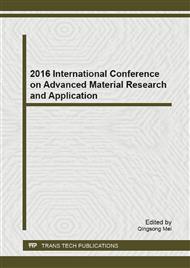p.128
p.134
p.138
p.146
p.152
p.161
p.168
p.173
p.178
Effects of Meso-Structure in Grinding of 2.5D Woven Fiber-Reinforced Ceramic Composites
Abstract:
Fiber-reinforced ceramic composites are relatively promising materials in aerospace and other high-tech area. In this work, the grinding mechanism of 2.5-dimensional woven quartz fiber-reinforced ceramic matrix composites was researched by experimental analysis. The acoustic emission (AE) combined with wavelet analysis was adopted to evaluate the grinding process. The ratio of energy which may indicate the mode of fracture of the composites was used for analyzing each of the AE signals levels. The effects of meso-structure on AE frequency distribution have been discussed. It was found that that specific frequency band is corresponding to the specific fracture mode, such as fiber fracture, interface debonding and matrix fracture. It indicates that grinding mechanism is highly dependent on the meso-structure of the composites.
Info:
Periodical:
Pages:
152-158
Citation:
Online since:
January 2017
Price:
Сopyright:
© 2017 Trans Tech Publications Ltd. All Rights Reserved
Share:
Citation:


